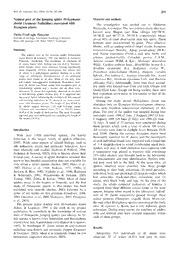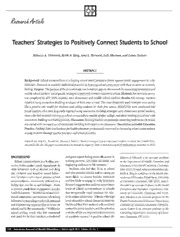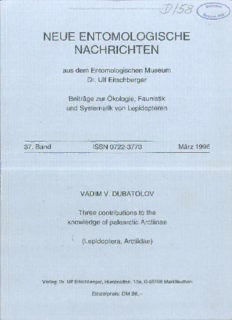
Preview neue entomologische nachrichten
J?158 ©Entomologisches Museum Dr. Ulf Eitschberger, download unter www.zobodat.at NEUE ENTOMOLOGISCHE NACHRICHTEN aus dem Entomologischen Museum Dr. Ulf Eitschberger Beiträge zur Ökologie, Faunistik und Systematik von Lepidopteren 37. Band ISSN 0722-3773 März 1996 VADIM V. DUBATOLOV Three contributions to the knowledge of palearctic Arctiinae (Lepidoptera, Arctiidae) Verlag: Dr. Ulf Eitschberger, Humboldtstr. 13a, D-95168 Marktleuthen Einzelpreis: DM 98,- ©Entomologisches Museum Dr. Ulf Eitschberger, download unter www.zobodat.at NEUE ENTOMOLOGISCHE NACHRICHTEN aus dem Entomologischen Museum Dr. Ulf Eitschberger Beiträge zur Ökologie, Faunistik und Systematik von Lepidopteren Herausgeber und Schriftleitung: Dr. ULF EITSCHBERGER, Humboldtstr. 13a, D-95168 Marktleuthen Die Zeitschrift und alle in ihr enthaltenen einzelnen Beiträge und Abbildungen sind urheberrechtlich geschützt. Jede Ver wertung außerhalb der engen Grenzen des Urheberrechts gesetzes ist ohne Zustimmung des Verlages unzulässig und strafbar. Das gilt insbesondere für Vervielfältigungen auf foto mechanischem Wege (Fotokopie, Mikrokopie), Übersetzun gen, Mikroverfilmungen und die Einspeicherung und Verar beitung in elektronischen Systemen. ISSN 0722-3773 ©Entomologisches Museum Dr. Ulf Eitschberger, download unter www.zobodat.at NEUE ENTOMOLOGISCHE NACHRICHTEN aus dem Entomologischen Museum Dr. Ulf Eitschberger Beiträge zur Ökologie, Faunistik und Systematik von Lepidopteren 37. Band ISSN 0722-3773 März 1996 VADIM V. DUBATOLOV Three contributions to the knowledge oi palearctic Arctiinae (Lepidoptera, Arctiidae) Verlag: Dr. Ulf Eitschberger, Humboldtstr. 13a, D-95168 Marktleuthen ©Entomologisches Museum Dr. Ulf Eitschberger, download unter www.zobodat.at ©Entomologisches Museum Dr. Ulf Eitschberger, download unter www.zobodat.at Three contributions to the knowledge of palearctic Arctiinae (Lepidoptera: Arctiidae) by Vadim V. Dubatolov 1. Sinowatsonia, a new genus of Arctiidae from Tibet (China) (on the systematics of the genus Micrarctia Seitz s. I.p Part 2). 2. A review of the genus Palearctia Ferguson (on the systematics of the genus Micrarctia Seitz s. I., Part 3). 3. A list of the Arctiinae of the territory of the former U.S.S.R. ©Entomologisches Museum Dr. Ulf Eitschberger, download unter www.zobodat.at ©Entomologisches Museum Dr. Ulf Eitschberger, download unter www.zobodat.at 5 - - 1. Sinowatsonia, a new genus of Arctiidae from Tibet (China) (on the systematics of the genus Micrarctia Seitz s. I., Part 2) (Lepidoptera: Arctiidae) by V. V. Dubatolov The genus Micrarctia Seitz, 1910 s. I. was divided by Ferguson (1984) and Dubatolov (1987) into several genera: Micrarctia Seitz, 1910 (M. trígona (Leech, 1899)), Sinoarctia Dubatolov, 1987 (S. kasnakovi Dubatolov, 1987, S. sieversi (Grum-Grshimailo, 1891), S. forsteri (Daniel, 1943) and (a personal communication of the late W. Thomas) S. mussoti (Oberthür, 1911)), Ocnogynodes Dubatolov, 19871 (O. y-albula (Oberthür, 1886)), Sibirarctia Dubatolov, 1987 (S. kindermanni (Staudinger, 1867), S. buraetica (O. Bang-Haas, 1927)), and Palearctia Ferguson, 1984 (a series of Central-Asian species). However, there are two species described by Daniel (1943) from East Tibet, which do not belong to any of these genera: Micrarctia hoenei Daniel, 1943, and Micrarctia batangi Daniel, 1943. They turned out to belong to a separate genus within the tribe Spilosomini. This new genus is described in this paper. The author expresses his sincere gratitude to Dr. A. Watson at The Natural History Museum, London, for offering the male and female of M. hoenei (Daniel)1 2 and the photographs of M. batangi (Daniel) for this study. I wish to express my thanks to Dr. O. E. Kosterin (Novosibirsk) for his help in translating the manuscript. This work was partly supported by the International Science Foundation and the Russian Academy of Natural Sciences. Sinowatsonia gen. nov. Type-species: Micrarctia batangi Daniel, 1943. The wings are well developed in both sexes. The forewing is rather narrow, its apex slightly prominent (colour plate fig. 1a, b). The pattern consists of fused spots forming an Y-like pattern, with one branch oriented along the cubitus to the wing apex and the other from the cubitus to the tip of vein 1 (A). Vein 11 (R-|) starts from the apex of the cell, vein 10 (R2) from the 7+8 (R4+5) vein. The hindwing colour ation varies from white to carmine-red. In the males the head is densely covered with long erect hairs, in females they are substantially shorter. The palpae are moderately long, covered with thin hairs, in the males their underside is covered with long erect hairs. The eyes are naked, in the males relatively large, hemispheric, in the females oval, slightly convex. The antennae are bipectinate in males and serrate in females. The proboscis is reduced. The body is rather narrow, covered with sleeky hairs in males and sleeky scales in females. The fore tibia is simple, a little longer than half of the femora, the epiphysis is shorter than the tibia. The middle tibia is armed with a single pair, the hind tibia with two pairs of almost wedge-shaped spurs, which are slightly shorter than the tibia diameter. Male genitalia (figs 1, 2). The anterior part of the tegumen is wide, forming a “collar”, the valva is narrow, with a wide rounded tooth on the internal edge. The female genitalia have not been studied. 1 The genus Ocnogynodes Dubatolov, 1987 was united with Lithosarctia Daniel, 1954 by de Freina & Witt (1994). Now this genus includes three species: L. hoenei Daniel, 1954, L. y-albula (Ober- thur,'1886) and L. thomasi de Freina & Witt, 1994. 2 It should be noted that the female of M. hoenei (Daniel) in the collection of the The Natural History Museum (London) was determined as “Micrarctia seiversi Gr.-Gr.” ©Entomologisches Museum Dr. Ulf Eitschberger, download unter www.zobodat.at 6 - - Fig. 1: Male genitalia of Sinowatsonia batangi (Daniel, 1943). Holotype. a - general view, b - the aedeagus with the vesica everted, c - VIII. sternite. Photo by courtesy of Dr. A. Watson. Notes. Concerning the structure of the male genitalia, the two species of the new genus, S. hoenei (Daniel) and S. batangi (Daniel), are very similar to the species of the genus Ocnogyna Lederer, 1853, especially to O. parasita (Hübner, [1790]). However, they have two pairs of spurs on the hind tibia, the fore tibia is simple, and the females have normally developed wings (while all Ocnogyna species have a single pair of spurs on the hind tibia, a short fore tibia much widening to the tip, where it almost lacks scales and bears a large tooth; the females are wingless or brachypteric). These characters are shared with the genus Maurica de Freina & Witt, 1984. However, our species differ from the representatives of the latter genus by more prolonged forewings with the apices drawn off, by the presence of a tooth on the valva, and the presence of a “collar” on the tegumen (the Maurica species have rather short and broad wings, stick-shaped valvae, and the tegumen without a “collar”). Whereas the species of the genus Lithosarctia de Freina & Witt (= Ocnogynodes Dubatolov) re semble S. hoenei (Daniel) and S. batangi (Daniel) by wing colouration, they lack the “collar” on the tegumen (the presence of which is a characteristic of several genera of the tribe Spilosomini) and have the valva of quite a different shape. The wing colouration of the two species of Sinowatsonia gen. nov. resembles to some extent that of the representatives of the genera Eospilarctia Koda, 1988, and Paraspilarctia Köda, 1988, which also have the “collar” on the tegumen, but greately differ from them by the shape of the valva, aedeagus, its vesica and by some other characters. ©Entomologisches Museum Dr. Ulf Eitschberger, download unter www.zobodat.at 7 - - Fig. 2: Male genitalia of Sinowatsonia hoenei (Daniel, 1943). Paratype. “Li-kiang ca. 2000 m Prov. Nord-Yuennan 1.6.1934 H. Hone” a - general view, b - the aedeagus with the vesica everted. Key to the species of Sinowatsonia 1 (2) The hindwing is evenly pinkish-red in males and carmine-red in females. The distal part of the valva is three times narrower than the narrowest point of its proximal part. S. hoenei (Daniel, 1943) comb. nov. (China: Sichuan, Yunan, Tibet (Fang, 1982)) 2 (1) The hindwing is white with pink bases in males, females are unknown. The distal part of the valva is two times narrower than the narrowest point of its proximal part. S. batangi (Daniel, 1943) comb. nov. (China: Sichuan (Fang, 1982)) References Daniel, F. (1943): Beiträge zur Kenntnis der Arctiidae Ostasiens unter besonderer Berücksichtigung der Ausbeuten H. Hönes aus diesem Gebiet (Lep., Het.). II. Teil. Hypsinae, Micrarctiinae, Spilosominae, Arctiinae. - Mitt. Münch. Ent. Ges. 33 (2/3): 673-759, Taf. 14-22. Dubatolov, V. V. (1987): K sistematike roda Micrarctia Seitz, s. I. (Lepidoptera, Arctiidae) [On the systematics of the genus Micrarctia Seitz, s.I. (Lepidoptera, Arctiidae)]. In: Nasekomye, klestshi i gelminty [Insects, mites and helmints]. - Novosibirsk: “Nauka”, Sib. Dept., p. 30-47 (in russian). Fang cheng-Lai (1982): Arctiidae. - Iconographia heterocerorum sinicorum 2:190-277 (in Chinese). Ferguson, D. C. (1984): Two new generic names for groups of holarctic and palaearctic Arctiini (Lepidoptera, Arctiidae). - Proc. entomol. Soc. Wash. 86 (2): 452-459. Freina, J. J. de & T. J. Witt (1984): Taxonomische Veränderungen bei den Bombyces und Sphinges Europas und Nordwestafrikas. Zwei neue Arctiidaegattungen für den westpaläarktischen Faunenbereich: Watsonarctia gen. n. und Maurica gen. n. (Lepidoptera, Artctiidae). - Ento- mofauna 5 (28): 323-334. ©Entomologisches Museum Dr. Ulf Eitschberger, download unter www.zobodat.at 8 - - Freina, J. J. de & T. J. Witt (1994): Zur Kenntnis der Gattung Lithosarctia Daniel, 1954 mit Beschrei bung zweier neuer Taxa. - Atalanta 25 (3/4): 535-542, Farbtafel XVIIla. Köda, N. (1987/1988): A Generic Classification of the Subfamily Arctiinae of the Palaearctic and Oriental Regions based on the Male and Female Genitalia (Lepidoptera, Arctiidae). Part I. - Työ to ga 38(1987): 153-237; Part II. Työ to Ga 39(1988): 1-79. Explanation of the colour plate (p. 89): 1a 1b 1b Fig. 1a: Sinowatsonia batangi (Daniel, 1943). Flolotype 2. “Batang (Tibet) Im Tal des Yangtze (ca. 2800 m) 26.7.1936 H. Hone”. Photo by courtesy of Dr. A. Watson. Fig 1b: Sinowatsonia hoenei (Daniel, 1943). The female from the collection of The Natural History Museum (London) and its labels. Photo by courtesy of Dr. A. Watson.
Description:The list of books you might like

Haunting Adeline

A Thousand Boy Kisses

The 48 Laws of Power

Corrupt (Devil's Night #1)

When Death Becomes Life: Notes from a Transplant Surgeon
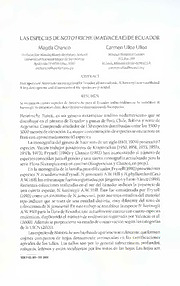
LAS ESPECIES DE NOTOTRICHE (MALVACEAE) DE ECUADOR

Come as You Are
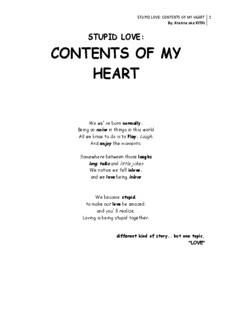
By: Kristine aka KITIN

By Mohamed Farouk Ahmed Mohamed

Games, Ideas and Activities for Primary Drama (Classroom Gems)
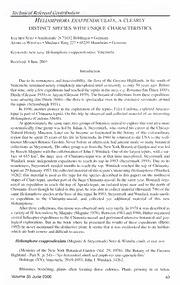
Heliamphora exappendiculata, a clearly distinct species with unique characteristics

Sledgehammers: Strengths and Flaws of Tiger Tank Battalions in World War II

West Knits Book Three

Remèdes de nos grand-mères en 150 recettes maison
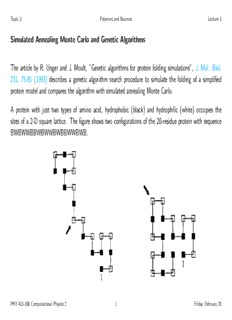
Simulated Annealing Monte Carlo and Genetic Algorithms The

Efficient Merger of Binary Supermassive Black Holes in Non-Axisymmetric Galaxies

Montana Ever After: The Wildes of Birch Bay Book 8 (BONUS story)

Taiko (10 buku)
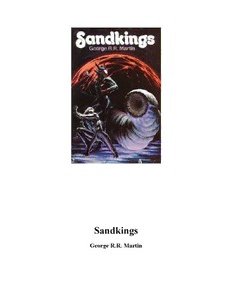
Sandkings

Greek Government Gazette: Part 3, 2006 no. 434


